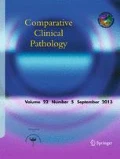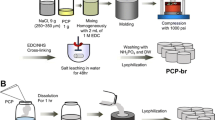Abstract
Decellularized cartilage extracellular matrix (ECM)-derived bioscaffolds have been designed as they provide a unique opportunity to carry out research on the mechanisms of chondrogenesis and its regulation. These scaffolds are used as a model in order to emulate different aspects relating to the formation, degeneration, and regeneration of the cartilage. This project has studied the interaction between the decellularized bovine articular cartilage and the blastema cells derived from the punched rabbit’s ear. Articular cartilage was dissected in fragments with 10 mm length and 2 mm thickness. Then, they were chemically decellularized with 2% sodium dodecyl sulfate (SDS) for 2 h. The tissue rings derived from the rabbit’s ear were assembled with the decellularized scaffolds and they were placed in a culture media for 30 days. These samples were fixed, sectioned, and microscopically studied. Micrographs of SEM electron microscopy and DAPI staining confirmed the decellularization of the scaffolds. FTIR analysis confirmed the preservation of ECM components including collagen II and proteoglycans. The optical microscopy observations confirmed migration, adherence, and penetration of the blastema cells into the scaffolds. The electron microscopy studies demonstrated that the blastema cells beside the scaffolds have triggered mutual interactions and merely progressed toward chondrogenic differentiation. The main objective is to identify and comprehend the interaction between cartilage matrix and blastema cells. The proposed model is an ideal model for fundamental studies in cartilage tissue engineering. The principles of tissue engineering must be taken in to account while studying such interactions.






Similar content being viewed by others
References
Aszodi A, Hunziker EB, Brakebusch C, Fassler R (2003) Beta1 integrins regulate chondrocyte rotation, G1 progression, and cytokinesis. Genes Dev 17:2465–2479
Baghaban Eslaminejad MR, Bordbar S (2013) Isolation and characterization of the progenitor cells from the blastema tissue formed at experimentally-created rabbit ear hole. Iran J Basic Med Sci. 16:109–115
Benders KE, van Weeren PR, Badylak SF, Saris DB, Dhert WJ, Malda J (2013) Extracellular matrix scaffolds for cartilage and bone regeneration. Trends Biotechnol 31:169–176
Bhattacharjee M, Coburn J, Centola M, Murab S, Barbero A, Kaplan DL, Martin I, Ghosh S (2015) Tissue engineering strategies to study cartilage development, degeneration and regeneration. Adv Drug Deliv Rev 84:107–122
Brockes JP, Kumar A (2002) Plasticity and reprogramming of differentiated cells in amphibian regeneration. Nat RevMol Cell Biol 3:566–574
Cheng CW, Solorio LD, Alsberg E (2014) Decellularized tissue and cell-derived extracellular matrices as scaffolds for orthopaedic tissue engineering. Biotechnol Adv 32:462–484
Choi JS, Kim BS, Kim JD, Choi YC, Lee HY, Cho YW (2012) In vitro cartilage tissue engineering using adipose-derived extracellular matrix scaffolds seeded with adipose-derived stem cells. Tissue Eng Part A 18:80–92
Darling EM, Athanasiou KA (2005) Rapid phenotypic changes in passaged articular chondrocyte subpopulations. J Orthop Res 23:425–432
Domm C, Schünke M, Christesen K, Kurz B (2002) Redifferentiation of dedifferentiated bovine articular chondrocytes in alginate culture under low oxygen tension. Osteoarthr Cartil 10:13–22
Elder BD, Eleswarapu SV, Athanasiou KA (2009) Extraction techniques for the decellularization of tissue engineered articular cartilage constructs. Biomaterials 30:3749–3756
Elder BD, Vigneswaran K, Athanasiou KA, Kim DH (2010) Biomechanical, biochemical, and histological characterization of canine lumbar facet joint cartilage. Neurosurgery 66:722–727
Geoffrion R, Murphy M, Robert M, Birch C, Ross S, Tang S, Milne J (2011) Vaginal paravaginal repair with porcine small intestine submucosa: midterm outcomes. Female Pelvic Med Reconstr Surg 17:174–179
Godman GC, Porter KR (1960) Chondrogenesis, studied with the electron microscope. J Biophys Biochem Cytol 8:719–760
Grauss RW, Hazekamp MG, Oppenhuizen F, van Munsteren CJ, Gittenberger-de Groot AC, DeRuiter MC (2005) Histological evaluation of decellularised porcine aortic valves: matrix changes due to different decellularisation methods. Eur J Cardiothorac Surg 27:566–571
Hartmann C, Tabin CJ (2001) Wnt-14 plays a pivotal role in inducing synovial joint formation in the developing appendicular skeleton. Cell 104:341–351
Hashemzadeh MR, Mahdavi-Shahri N, Bahrami AR, Kheirabadi M, Naseri F, Atighi M (2015) Use of an in vitro model in tissue engineering to study wound repair and differentiation of blastema tissue from rabbit pinna. In Vitro Cell Dev Biol Anim 51:680–689
Hoshiba T, Lu H, Yamada T, Kawazoe N, Tateishi T, Chen G (2011) Effects of extracellular matrices derived from different cell sources on chondrocyte functions. Biotechnol Prog 27:788–795
Khalil S, Sun W (2009) Bioprinting endothelial cells with alginate for 3D tissue constructs. J Biomech Eng 131:111002
Liao J, Guo X, Grande-Allen KJ, Kasper FK, Mikos AG (2010) Bioactive polymer/extracellular matrix scaffolds fabricated with a flow perfusion bioreactor for cartilage tissue engineering. Biomaterials 31:8911–8920
Lu H, Hoshiba T, Kawazoe N, Chen G (2012) Comparison of decellularization techniques for preparation of extracellular matrix scaffolds derived from three-dimensional cell culture. J Biomed Mater Res A 100:2507–2516
Malda J, van Blitterswijk CA, Grojec M, Martens DE, Tramper J, Riesle J (2003a) Expansion of bovine chondrocytes on microcarriers enhances redifferentiation. Tissue Eng 9:939–948
Malda J, Kreijveld E, Temenoff JS, van Blitterswijk CA, Riesle J (2003b) Expansion of human nasal chondrocytes on macroporous microcarriers enhances redifferentiation. Biomaterials 24:5153–5161
Martin I, Baldomero H, Bocelli-Tyndall C, Emmert MY, Hoerstrup SP, Ireland H, Passweq J, Tyndall A (2014) The survey on cellular and engineered tissue therapies in Europe in 2011. Tissue Eng Part A. 20:842–853
Musumeci G, Castrogiovanni P, Leonardi R, Trovato FM, Szychlinska MA, Di Giunta A, Loreto C, Castorina S (2014) New perspectives for articular cartilage repair treatment through tissue engineering: a contemporary review. World J Orthop 5:80–88
Padalino MA, Castellani C, Dedja A, Fedrigo M, Vida VL, Thiene G, Stellin G, Angelini A (2012) Extracellular matrix graft for vascular reconstructive surgery: evidence of autologous regeneration of the neoaorta in a murine model. Eur J Cardiothorac Surg 42:e128–e135
Place ES, Evans ND, Stevens MM (2009) Complexity in biomaterials for tissue engineering. Nat Mater 8:457–470
Roelofs AJ, Rocke JP, De Bari C (2013) Cell-based approaches to joint surface repair: a research perspective. Osteoarthr Cartil 21:892–900
Rosario DJ, Reilly GC, Ali Salah E, Glover M, Bullock AJ, Macneil S (2008) Decellularization and sterilization of porcine urinary bladder matrix for tissue engineering in the lower urinary tract. Regen Med 3:145–156
Schnabel M, Marlovits S, Eckhoff G, Fichtel I, Gotzen L, Vécsei V, Schlegel J (2002) Dedifferentiation-associated changes in morphology and gene expression in primary human articular chondrocytes in cell culture. Osteoarthr Cartil 10:62–70
Shakibaei M, De Souza P, Merker HJ (1997) Integrin expression and collagen type II implicated in maintenance of chondrocyte shape in monolayer culture: an immunomorphological study. Cell Biol Int 21:115–125
Simkin J, Sammarco MC, Dawson LA, Schanes PP, Yu L, Muneoka K (2015) The mammalian blastema: regeneration at our fingertips. Regeneration 2:93–105
Tavassoli A, Moghaddam Matin M, Akbarzade Niaki M, Mahdavi-Shahri N, Shahabipour F (2015) Mesenchymal stem cells can survive on the extracellular matrix-derived decellularized bovine articular cartilage scaffold. Iran J Basic Med Sci 18:1221–1227
Ten Koppel PG, van Osch GJ, Verwoerd CD, Verwoerd-Verhoef HL (2001) A new in vivo model for testing cartilage grafts and biomaterials: the rabbit pinna punch-hole model. Biomaterials 22:1407–1414
Vinatier C, Mrugala D, Jorgensen C, Guicheux J, Noël D (2009) Cartilage engineering: a crucial combination of cells, biomaterials and biofactors. Trends Biotechnol 27:307–314
Yang Z, Shi Y, Wei X, He J, Yang S, Dickson G, Tang J, Xiang J, Song C, Li G (2010) Fabrication and repair of cartilage defects with a novel acellular cartilage matrix scaffold. Tissue Eng Part C Methods 16:865–876
Yang Q, Peng J, Lu SB, Guo QY, Zhao B, Zhang L, Wang AY, Xu WJ, Xia Q, Ma XL, Hu YC, Xu BS (2011) Evaluation of an extracellular matrix-derived acellular biphasic scaffold/cell construct in the repair of a large articular high-load-bearing osteochondral defect in a canine model. Chin Med J 124:3930–3938
Acknowledgements
We acknowledge Science and Research Branch of Islamic Azad University of Tehran for the financial grant of this project. Authors would like to pay tribute to Dr. Elaheh Kafshdar Goharshadi from Chemistry Group of Faculty of Science and Technology, Mr. Jabbari and the personnel of the Central Laboratory of Ferdowsi University of Mashhad and, Mrs. Naderi from Islamic Azad University of Mashhad for their assistance and guidelines.
Author information
Authors and Affiliations
Corresponding author
Ethics declarations
Conflict of interest
The authors declare that they have no conflicts of interest.
Ethical statement
Experiments were performed in strict compliance with the University of Mashhad Animal Ethics Guidelines in accordance with the Iran Animal Welfare Act.
Rights and permissions
About this article
Cite this article
Mohammadie, Z.M., Parivar, K., Shahri, N.M. et al. Ultrastructure of bioscaffolds derived from bovine articular cartilage as an experimental model to support blastema cells. Comp Clin Pathol 26, 1173–1181 (2017). https://doi.org/10.1007/s00580-017-2505-4
Received:
Accepted:
Published:
Issue Date:
DOI: https://doi.org/10.1007/s00580-017-2505-4




